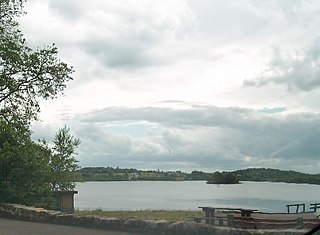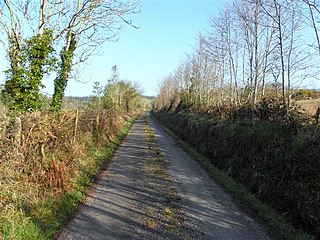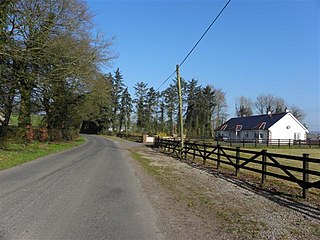
Kilsob (from Irish Coill Subh meaning "Wood of the Berries") is a townland in the civil parish of Templeport, County Cavan, Ireland. It lies in the Roman Catholic parish of Templeport and barony of Tullyhaw.

Kilsob (from Irish Coill Subh meaning "Wood of the Berries") is a townland in the civil parish of Templeport, County Cavan, Ireland. It lies in the Roman Catholic parish of Templeport and barony of Tullyhaw.
Kilsob is bounded on the north by Erraran and Bawnboy townlands, on the west by Newtown, Lakefield and Mullaghmore, Templeport townlands, on the south by Kildoagh townland and on the east by Muinaghan and Corrasmongan townlands. The town of Bawnboy is partly situate in the north part of the townland and was sometimes referred to as Kilsob in the past, rather than Bawnboy. Its chief geographical features are Bellaboy Lough (Irish = Loch Béal Átha Buí = The Lake of the Entrance to the Yellow Ford), the Bawnboy River, a stone quarry and dug wells. Kilsob is traversed by the national secondary N87 road (Ireland), the L1037 road, minor roads and rural lanes. The townland covers 348 statute acres. [1]
In medieval times the McGovern barony of Tullyhaw was divided into economic taxation areas called ballibetoes, from the Irish Baile Biataigh (Anglicized as 'Ballybetagh'), meaning 'A Provisioner's Town or Settlement'. The original purpose was to enable the farmer, who controlled the baile, to provide hospitality for those who needed it, such as poor people and travellers. The ballybetagh was further divided into townlands farmed by individual families who paid a tribute or tax to the head of the ballybetagh, who in turn paid a similar tribute to the clan chief. The steward of the ballybetagh would have been the secular equivalent of the erenagh in charge of church lands. There were seven ballibetoes in the parish of Templeport. Kilsob was located in the ballybetagh of "Balleagheboynagh" (alias 'Ballyoghnemoynagh'). The original Irish is Baile Na Muighe Eanach, meaning 'The Town of the Marshy Plain'). The ballybetagh was also called "Aghawenagh", the original Irish is Achadh an Bhuí Eanaigh, meaning 'The Field of the Yellow Bog').
A subdivision of the townland is named Rossilk or Ruserk.
The 1609 Ulster Plantation Baronial Map depicts the townland as Kilsobb. [2] [3]
In the Plantation of Ulster by grant dated 26 June 1615, King James VI and I granted, inter alia, four polls in Killsobb to Sir George Graeme and Sir Richard Graeme to form part of the Manor of Greame. [4] An Inquisition held at Cavan Town on 31 October 1627 found that Sir Richard Greames of Corrasmongan died on 7 November 1625 seized of, inter alia, four polls in Kilsob. His son and heir Thomas Greames was aged 40 (born 1585) and married. [5] After the Cromwellian Act for the Settlement of Ireland 1652 the Graham family were still in possession of Kilsob.
In the Hearth Money Rolls compiled on 29 September 1663 [6] there was one person paying the Hearth Tax in- Kilsobb- Mr. John Brench.
By a deed dated 7 January 1746 between- Veaitch Betty of Kilsob in the County of Cavan, Gentleman of the one part and Bryan Reilly & Patrick McKiernan of Middle Kilsob of the other part, the said Veaitch Betty leased land for 21 years to said Bryan Reilly & Patrick McKiernan in Middle Killsob. Witnesses: Terence Kiernan of the City of Dublin & John Beatty of Swadlingbar & George Booth near Drumersnaw, Co. Leitrim.
The aforesaid Reverend Veaitch Betty of Lakefield, Templeport by his will dated 16 July 1783 (Born 1709. Died August 1785. Probate granted July 1796) stated- To be buried in the vault I made at Temple Piert. To my dear wife Mary Betty the houses and demesne of Lakefield with the mill race and ten acres whereon the mill is built provided she keeps unmarried, and after her demise to my eldest son Rowland Betty. To my daughters, Susanna Betty and Ann Betty, £300 each to be paid out of the lands of Kilsob. To my second son William Betty the farm of land known as Middle Kilsob or Gortenane, and his heirs. To my eldest son Rowland Betty the lands of Newtown known by the name of Tony McCallan, the farm of Lower Kilsob and the farm of Mullaghmore, the above lands not to be taken over until my debts and the children's fortunes are paid. Should either son die without male heirs then to the elder surviving daughter of either. To my said son William Beatty the lease of Gortnacarrig, County Cavan, made to me by the Right Honourable Lord Farnham and the lease of Lavaghmore, Co. Leitrim, made to me by Samuel Campbell, Esq. To my granddaughter I
| Year | Population | Males | Females | Total Houses | Uninhabited |
|---|---|---|---|---|---|
| 1841 | 194 | 100 | 94 | 32 | 0 |
| 1851 | 173 | 83 | 90 | 30 | 3 |
| 1861 | 157 | 77 | 80 | 31 | 1 |
| 1871 | 156 | 82 | 74 | 28 | 0 |
| 1881 | 133 | 68 | 65 | 26 | 4 |
| 1891 | 139 | 70 | 69 | 24 | 2 |
In the 1901 census of Ireland, there are thirty nine families listed in the townland, [7] and in the 1911 census of Ireland, there are forty four families listed in the townland. [8]
The chief structures of historical interest in the townland are

Porturlan is a townland in the civil parish of Templeport, County Cavan, Ireland. It lies in the Roman Catholic parish of Templeport and barony of Tullyhaw.

Brackley is a townland in the civil parish of Templeport, County Cavan, Ireland. It lies in the Roman Catholic parish of Templeport and barony of Tullyhaw.
Gortnavreeghan is a townland in the civil parish of Templeport, County Cavan, Ireland. It lies in the Roman Catholic parish of Templeport and barony of Tullyhaw.

Killycrin is a townland in the civil parish of Templeport, County Cavan, Ireland. It lies in the Roman Catholic parish of Templeport and barony of Tullyhaw.
Cor is a townland in the civil parish of Templeport, County Cavan, Ireland. It lies in the Roman Catholic parish of Templeport and barony of Tullyhaw.

Bellaleenan is a townland in the civil parish of Templeport, County Cavan, Ireland. It lies in the Roman Catholic parish of Templeport and barony of Tullyhaw.

Muinaghan is a townland in the civil parish of Templeport, County Cavan, Ireland. It lies in the Roman Catholic parish of Templeport and barony of Tullyhaw.
Cloncurkney is a townland in the civil parish of Templeport, County Cavan, Ireland. It lies in the Roman Catholic parish of Templeport and barony of Tullyhaw.

Mullaghmore is a townland in the civil parish of Templeport, County Cavan, Ireland. It lies in the Roman Catholic parish of Templeport and barony of Tullyhaw.

Ballynamaddoo is a townland in the civil parish of Templeport, County Cavan, Ireland. It lies in the Roman Catholic parish of Templeport and barony of Tullyhaw.

Erraran (from Irish Airearan, meaning 'Land bordering a Lake' is a townland in the civil parish of Templeport, County Cavan, Ireland. It lies in the Roman Catholic parish of Templeport and barony of Tullyhaw.
Mullaghlea is a townland in the civil parish of Templeport, County Cavan, Ireland. It lies in the Roman Catholic parish of Templeport and barony of Tullyhaw.

Killyneary is a townland in the civil parish of Templeport, County Cavan, Ireland. It lies in the Roman Catholic parish of Templeport and barony of Tullyhaw.
Lakefield is a townland in the civil parish of Templeport, County Cavan, Ireland. It lies in the Roman Catholic parish of Templeport and barony of Tullyhaw.
Newtown is a townland in the civil parish of Templeport, County Cavan, Ireland. It lies in the Roman Catholic parish of Templeport and barony of Tullyhaw.
Munlough North is a townland in the civil parish of Templeport, County Cavan, Ireland. It lies in the Roman Catholic parish of Templeport and barony of Tullyhaw. It is named Munlough North to distinguish it from the neighbouring townland of Munlough South.

Arderry is a townland in the civil parish of Templeport, County Cavan, Ireland. It lies in the Roman Catholic parish of Corlough and barony of Tullyhaw.

Tawnagh is a townland in the civil parish of Templeport, County Cavan, Ireland. It lies in the Roman Catholic parish of Corlough and barony of Tullyhaw.
Moneynure is a townland in the civil parish of Templeport, County Cavan, Ireland. It lies in the Roman Catholic parish of Corlough and barony of Tullyhaw.

Gortnacargy is a townland in the civil parish of Templeport, County Cavan, Ireland. It lies in the Roman Catholic parish of Corlough and barony of Tullyhaw.